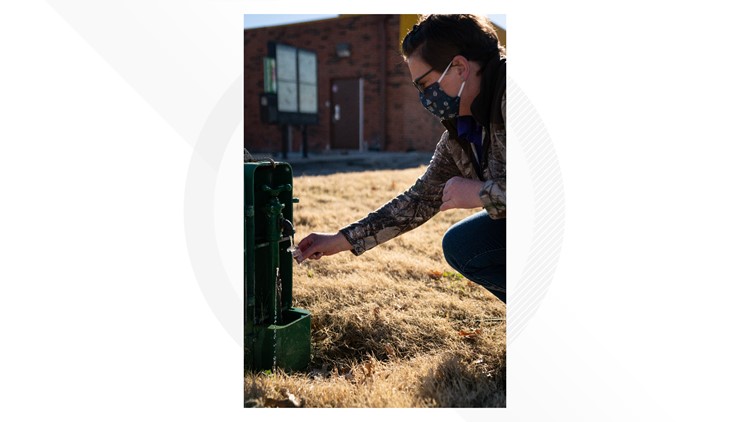SAN ANGELO, Texas — In February, after numerous complaints from PaulAnn residents about an odor in the tap water, the City of San Angelo issued a citywide "do-not-use" water notice.
In the days and weeks to come, parts of the City were upgraded to "do-not-drink," then released altogether from any water restrictions.
The PaulAnn area continues to be in a "do-not-drink" situation.
City officials say the source of the water contamination is "industrial", however, the source remains unidentified.
Tuesday afternoon, the City's Public Information Office issued an update, along with a frequently-asked questions sheet for residents.
Here is the statement in full:
The City of San Angelo, along with other officials across Texas, are continuing to investigate the cause of the water contamination that occurred around Feb. 8 in the PaulAnn area. All personnel involved are working diligently to identify the potential source and ensure there are no ongoing concerns.
The contamination issue was not a source water issue; it was isolated to the PaulAnn and northern industrial areas of the city. The northern industrial area is still under a do-not-drink order. The City of San Angelo is delivering bottled drinking water on a regular basis to the 29 residents who reside in this area.
The businesses in this area have worked with the City to provide access to their facilities. We will be working with these facilities to improve their plumbing systems and further protect the City’s water system.
This is truly a needle-in-a-haystack kind of investigation because the chemical volume that caused the contamination could have been less than a gallon. We do believe this was a one-time occurrence rather than an ongoing issue.
Below are some frequently asked questions regarding the contamination issue and the efforts being made to identify the source:
- What has been done in regard to investigating potential businesses or contamination sites?
Under our Disaster Declaration, the City of San Angelo was able to request additional assistance from the State of Texas. Inspectors from McAllen, Lubbock, Brownwood and Abilene – who were sent by the State – have been inspecting businesses in the northern industrial area. The Texas Commission on Environmental Quality (TCEQ) is currently conducting its own investigation in that area, as well.
A total of 85 facilities and businesses located in the northern industrial and PaulAnn areas have been inspected. As a result, locations with inadequate protection will be required to upgrade or install additional backflow devices to help protect the City’s potable water supply.
- Explain the investigation process; what were investigators looking for?
The inspectors sent by the State have Customer Service Inspector (CSI) certifications and specialize in identifying deficiencies in commercial plumbing inspections.
A customer service inspection is an examination of the customer’s side of the water distribution system. The inspection is limited to the identification and prevention of cross-connections, potential contamination hazards and illegal lead materials. The CSIs analyze every end-point use of water to determine if a cross-connection between the facility and the water system exists, if additional backflow protection devices are needed, or if all requirements are met and a cross-connection is not present.
The City of San Angelo will be hiring several CSIs in the near future and will be implementing a more rigorous cross contamination program citywide to greatly reduce the likelihood of an issue like this happening again.
- Has the City figured out who is responsible for contaminating the water? If not, will they ever?
At this point, inspectors have not found direct evidence linking the contamination to a specific site. Our investigators continue to explore and investigate all possibilities. Some have inquired about whether or not the City was protecting the guilty party; the answer to that is no. The City wants to find the party responsible as much as everyone else does. It’s important to note that this investigation is being conducted by more than just the City of San Angelo; the State of Texas, through TCEQ, is also investigating the incident. As the investigation continues in the area, more and more businesses are excluded as the potential source.
- If the City can’t locate the site, will the northern industrial area ever be released from restrictions and placed back on the system? If that does happen, what assurances do citizens have that the contamination won’t happen again?
Currently, the area remains valved off from the rest of the water system. It will be some time before those valves are opened and the northern industrial area is released from the current do-not-drink advisory. Both of these steps are being taken to make sure any deficiencies found during the investigation process are fixed and addressed before returning to normal operations. To further ensure there are no ongoing issues, both the PaulAnn and northern industrial areas will continue to be tested weekly to make sure there are no contaminates found in the water.
Don’t businesses have to report the chemicals they use? If so, why doesn’t the City know which business is responsible?
Under Tier 2 regulations by the TCEQ, businesses are required to report hazardous chemicals stored on site that reach a certain weight threshold to state and local officials, such as the Fire Department and the Emergency Management Division. If stored chemicals do not reach these thresholds, then they do not have to be reported to state or local officials. Based on the volume of chemicals found in the water, it is not expected that the chemicals were being kept in reportable quantities. The amount of chemicals that caused the contamination could have been less than one gallon.




